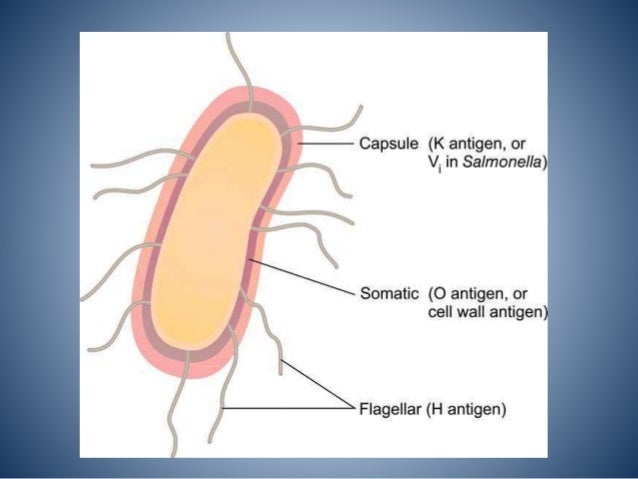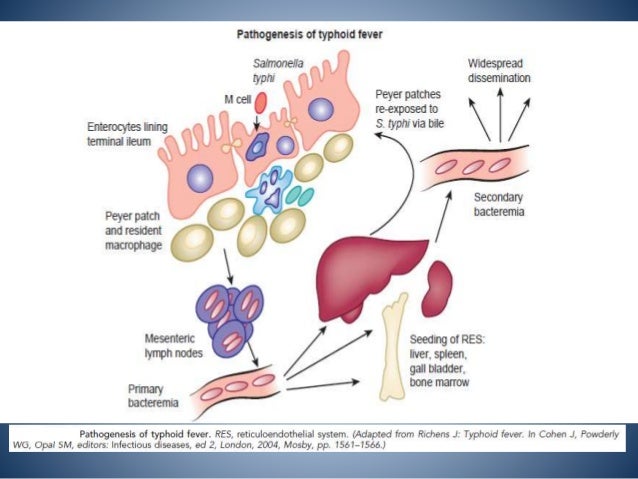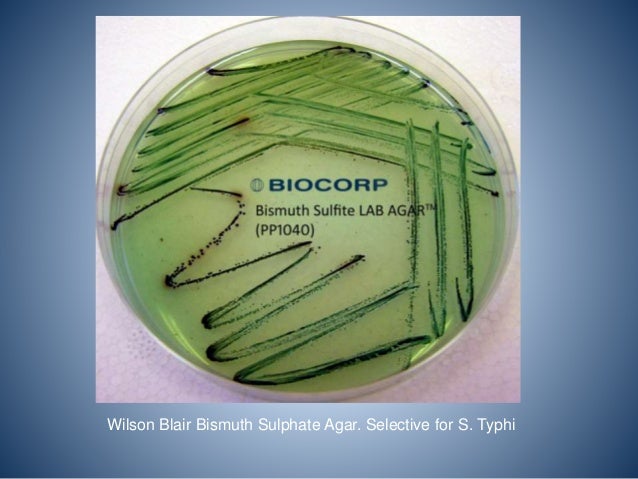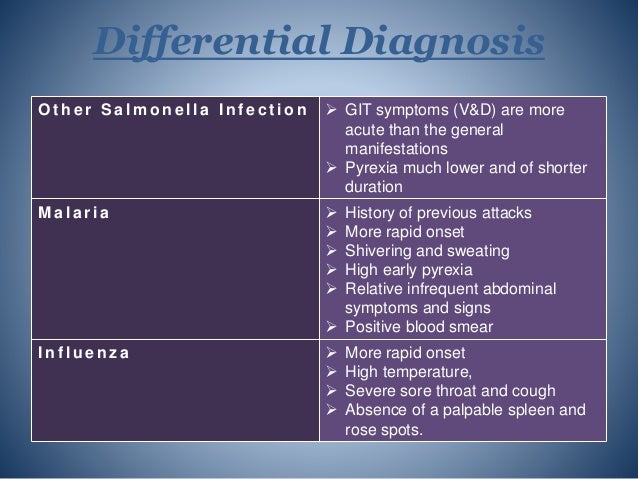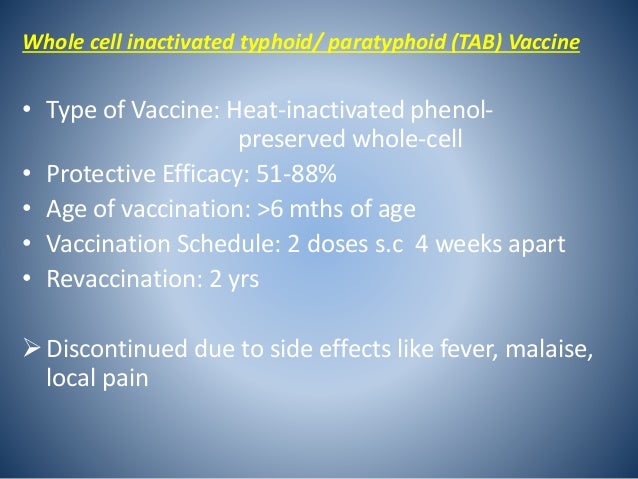https://www.slideshare.net/dragarwalankit/enteric-fever-51053483
What Is Typhoid?
Typhoid is the infection caused by Salmonella typhimurium (S.typhi) bacteria. The bacteria live within the intestines and bloodstreams. The condition spread through direct contact with the feces of a sufferer. It is noticeable that no animal carries this condition, so transmission is from human to human, always.
From the bloodstream, typhoid bacteria spread into other organs and tissues. In fact, the immune system of the sufferer could do rather little to combat the condition because salmonella typhimurium could live in the cells of the sufferer, safe from his/her immune system.
How To Avoid Typhoid?
It is estimated that people in those countries which have less access to washing facilities and clean water typically have a higher risk of getting typhoid. Typhoid is spread by the ingestion and contact of infected feces (of human beings). This could happen when handling the foods or through an infected source of water.
To minimize the risk of having typhoid, there are some rules you should follow:
- Drink bottled plain water.
- If you cannot find quality bottled water, make sure that the water is heated on a rolling boil for a few minutes before consuming.
- Be careful at eating something handled by another person.
- Do not eat at street food stands; just eat food which is still piping hot.
- Avoid having ice cubes in drinks.
- Avoid raw fruits and veggies.
- Peel the fruit before eating.
Key points
- Typhoid fever is an infection. It is caused by bacteria.
- Children can become very sick or even die without treatment.
- The disease is common in countries with poor sanitation.
- If your child is showing symptoms of typhoid fever, seek medical help right away.
- Children over two years can be vaccinated. Speak to your doctor before travelling.
Signs and symptoms
Signs and symptoms appear about seven to 14 days after catching the disease. Some children may not become sick for as long as two months after exposure. Signs and symptoms of typhoid fever may include:
- a persistent fever that rises gradually to 39°C to 40°C (102°F to 104°F)
- a headache
- a sore throat
- tiredness
- low energy
- stomach pain
- constipation
- diarrhea
- a temporary rash with raised pink spots on the stomach or chest
If your child is showing symptoms of typhoid fever, take them to a doctor right away.
When treated, the symptoms usually subside several days after the start of antibiotics. Left untreated, typhoid fever can lead to severe illness, even death.
Causes
Typhoid fever is caused by bacteria. The bacteria is most often found in food or water contaminated by an infected person. Infection can also occur when food or drink is served by an infected person who has not washed after using the bathroom.
Risk factors
Your child may be at higher risk of infection if they travel in a country where the fever is common. Having close contact with an infected person increases chances of infection. Children with weak immune systems are also at a greater risk of getting sick.
Treatment
Your child may need to give samples of stool, urine or blood for testing. Your child will likely be treated with oral antibiotics. In severe cases, the antibiotics are given intravenously.
Prevention
Prevention is the best way to protect your child against typhoid fever.
Here are some simple steps to reduce your child’s chances of catching this infection.
Drink bottle water only
Contaminated drinking water is a common source of the infection. Stick to bottled water or canned carbonated drinks.
Keep hands clean
Teach your child to wash hands frequently. Wash with warm, soapy water before eating food. Also wash after using the toilet. Alcohol-based hand sanitizer can kill germs when water is not available.
Only eat fruits and vegetables you can peel
Raw fruit or vegetables may have been washed in contaminated water. Only eat produce that can be peeled, like bananas.
Vaccinations
There is a typhoid vaccine that can be used in children older than two years. Speak with your doctor about the vaccinating your child.
Complications
If typhoid fever is not treated quickly, your child may become very ill. Intestinal bleeding or other damage may occur. Other complications may include:
- severe weight loss
- severe diarrhea
- persistent high fever
- becoming unresponsive
- delirium or hallucinations
*******************************************************
What Is Typhoid Fever?
Typhoid fever is a serious and sometimes life-threatening infection. It mostly affects people in developing countries, where sanitation is poor and getting clean water is a problem.
What Causes Typhoid Fever?
Typhoid fever is caused by bacteria called Salmonella typhi (S. typhi), which are related to the salmonella bacteria that cause food poisoning. They typically live in humans and are shed through a person’s feces (poop) or urine (pee).
The infection happens when a person eats or drinks something contaminated with the bacteria. When the bacteria get into the body, they quickly multiply and spread into the bloodstream.
What Are the Signs & Symptoms of Typhoid Fever?
Typhoid fever can come on suddenly or very gradually over a few weeks. The disease usually causes a high fever, a stomachache, and achiness a week or two after exposure to the bacteria (but sometimes later).
If the infection isn’t treated, a person may lose weight; develop a swollen or bloated belly; or develop a red, spotted rash on the lower chest or upper belly. Without treatment, typhoid fever may last a month or more and become very serious, even life-threatening.
In most cases, the symptoms start to go away in the third and fourth weeks, as long as the disease doesn’t cause any other health problems. Sometimes, after the illness seems gone it can come back.
After recovering from typhoid fever, some people become carriers of the bacteria. This means that they’ll have no symptoms, but do have the bacteria in their bodies and can pass it on to others.
Who Gets Typhoid Fever?
Typhoid in the U.S. is rare. But if you plan to travel to a foreign country (especially South-central and Southeast Asia, Africa, Latin America, or the Caribbean), it’s a good idea to talk to your doctor about prevention and treatment of typhoid fever.
People usually get typhoid fever by drinking beverages or eating food that has been handled by someone who has typhoid fever or is a carrier of the illness. Those infected also can pass the disease to others directly (for example, by touching them with unwashed hands). People also get the illness by drinking water that is contaminated by sewage.
How Is Typhoid Fever Diagnosed?
The doctor will evaluate the symptoms and ask you about your child’s medical history and recent travels. The doctor probably will take a sample of stool (poop), urine (pee), or blood to test it for the disease.
How Is Typhoid Fever Treated?
Typhoid fever is treated with antibiotics that kill the bacteria. It’s important to take the medicine for the whole time that the doctor prescribes, even if your child feels better. If you stop it too soon, some bacteria could remain.
Most kids start feeling better within 2 to 3 days of beginning treatment. Offer your child plenty of fluids to prevent dehydration. Kids who are severely dehydrated due to diarrhea might need to get IV (intravenous) fluids in a hospital or other medical care facility.
Acetaminophen can help reduce fever and make your child feel more comfortable. Call a doctor immediately if your child’s symptoms last, if they go away and come back, or if your child has any new symptoms.
Kids with typhoid fever should stay home until the disease has run its course and a doctor makes sure that the bacteria are gone. The same goes for teens who work in the food service industry, who may not legally be allowed to return to work until a doctor has proven them to be free of the bacteria.
Can Typhoid Fever Be Prevented?
Two typhoid vaccines are available in the U.S. One is a series of capsules and the other is an injection. In some cases, a booster is needed.
The typhoid vaccine is not a routine childhood vaccination. If your child is traveling to an area where typhoid fever is common, you’ll need to ask your doctor for the vaccine. Kids should be vaccinated at least 1 to 2 weeks before travel. This gives the vaccine time to take effect.
What Else Should I Know?
Even if everyone in your family has been vaccinated, vaccines are not completely effective and lose effectiveness over time. So take these precautions in high-risk areas:
- Sanitize water. Boil or disinfect any water that will be used for drinking, washing or preparing food, making ice, or brushing teeth. Better yet, try to drink only bottled water (carbonated is safer than regular) or other drinks that come in cans or bottles, but wipe the outside of the can or bottle before drinking from it. Tell kids to avoid tap water, fountain drinks, and ice cubes, and remind them to not swallow any water in the shower or bath.
- Cook all food. Fully cook all food, and avoid food from street vendors and food stored or served at room temperature. Instead, serve packaged foods or meals that are freshly cooked and served steaming hot.
- Avoid raw food. Avoid raw, unpeeled fruits and vegetables that may have been washed with contaminated water, especially lettuce and fruits like berries that can’t be peeled. Bananas, avocados, and oranges make better choices, but be sure you peel them yourself. For safety’s sake, you may want your kids to avoid raw foods entirely.
- Wash hands well and often. Wash with soap and clean, warm water, especially after kids use the bathroom or before they eat or prepare food. If no soap and water are available, use an alcohol-based hand sanitizer.



